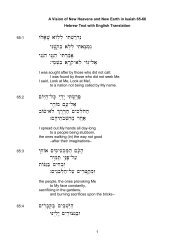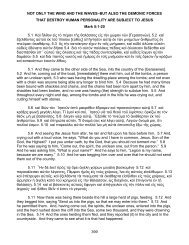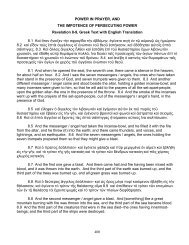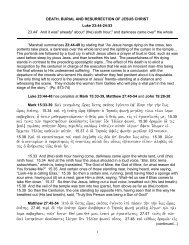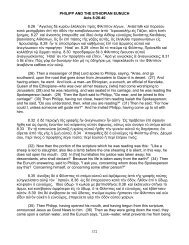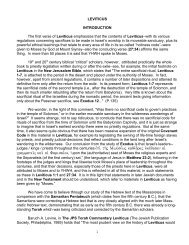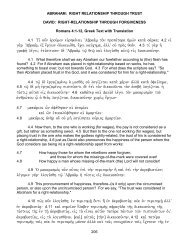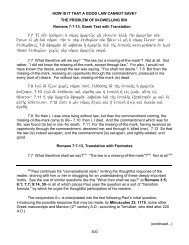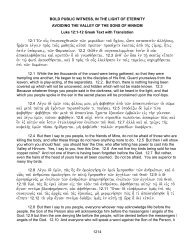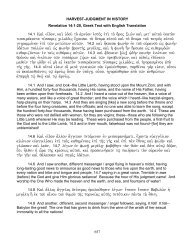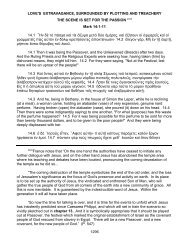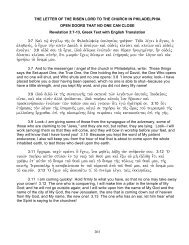Revelation 20 - In Depth Bible Commentaries
Revelation 20 - In Depth Bible Commentaries
Revelation 20 - In Depth Bible Commentaries
Create successful ePaper yourself
Turn your PDF publications into a flip-book with our unique Google optimized e-Paper software.
2271<br />
(...continued)<br />
they can easily return to the "abyss," placing themselves within reach of the adversary, and<br />
quickly succumb to its demonic attack? It is noteworthy that even in John's highly optimistic<br />
vision of the binding of the adversary for a thousand years, still, at the end of that long period,<br />
the adversary is released from his prison, and comes against the beloved city that is like a<br />
besieged camp--indicating that the power of evil, while broken and conquered, is not totally<br />
vanquished–it has been “curtailed” for a certain length of time, but it has not been destroyed.<br />
<strong>In</strong> symbolic language, that is a way of holding that the major victory over all the evil<br />
forces in human history has been won, but there is still human freedom, still decisions to be<br />
made, dangers to be faced, and battles to be fought with evil!<br />
Beasley-Murray points out that "...The image of the binding and imprisonment of the<br />
devil has a long and diffuse history in the religions and folk lore of the nations. The Zend<br />
religion of Persia has a clear relation to it, but from the point of view of the <strong>Revelation</strong> it is<br />
curiously topsy-turvy. <strong>In</strong> the Bundehesh it is related that the wicked serpent Azi-Dahaka is<br />
overcome by Thraetaeona and chained in a mountain for 9,000 years. He is released by the<br />
evil spirit Ahriman to reign for 1,000 years, but is finally slain, and the new world arrives...<br />
“Other parallels have been noted in the Egyptian myth of Osiris, the Mandaean traditions,<br />
and the Scandinavian and Germanic myths. Nearer at hand than these are the precedents<br />
in the Old Testament and in Jewish apocalyptic literature. [See Prayer of Manasseh<br />
3, where the Lord God is described as ‘He Who bound the sea...Who closed the bottomless<br />
pit and sealed it by his powerful and glorious name’]...<br />
“The important thing to observe is that the symbolism common to these myths is made<br />
a medium by John for a message which was conveyed to him alike through the Old Testament<br />
prophets and by the apostolic traditions of the teaching of Jesus, namely, that the powers<br />
of evil are doomed by the word of God. The subjugation of the devil and his removal from<br />
the sphere of man's existence is characteristic of the biblical monotheistic religion of redemption,<br />
which cannot endure the notion that evil will be prevalent for ever. The removal of satan,<br />
therefore, is integral to the good news of Jesus Christ. It is a complement of that teaching<br />
which lies at the heart of the Christian gospel, that the kingdom of God comes through the<br />
Christ and will triumph in history through Him. The defeat of satan and the triumph of the kingdom<br />
are essential elements in the acts of judgment and redemption which God accomplishes<br />
through the Christ." (Pp. 286-87)<br />
Aune states that “The notion of ‘binding’ (dei/n), particularly when used of supernatural<br />
beings, is drawn from the world of magic...The metaphor of ‘binding,’ i.e., imprisoning satan or<br />
demons, particularly until the day of judgment, occurs frequently in Judaism.’” (P. 1082)<br />
For mentions of the "binding" of the adversary in Jewish non-biblical literature, see the<br />
following passages:<br />
996<br />
(continued...)



